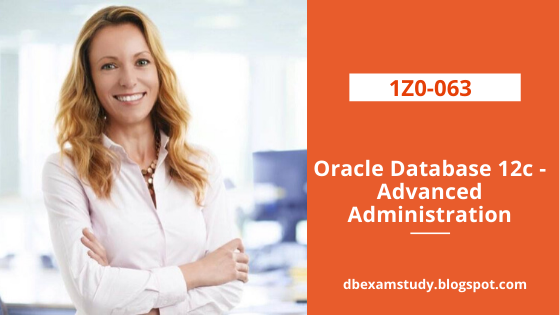Oracle 1Z0-063 Exam Details:
Exam Name
|
Oracle Database 12c - Advanced Administration
|
Exam Code
|
1Z0-063
|
Exam Product Version
|
Oracle Database 12c
|
Exam Price
|
USD $245 (Price may vary by country or by localized currency)
|
Duration
|
120 minutes
|
Number of Questions
|
80
|
Passing Score
|
60%
|
Recommended Training
|
|
Format
|
Multiple Choice Questions (MCQ)
|
Recommended Training
|
|
Recommended Practice
|
Oracle 1Z0-063 Syllabus Topics:
| Backup and Recovery | |
| Oracle Data Protection Solutions |
1. Explain Oracle backup and recovery solutions ◉ Describe types of database failures |
| Performing Basic Backup and Recovery | - Back up and recover a NOARCHIVELOG database - Perform backup and recovery in NOARCHIVELOG mode - Use SQL in RMAN |
| Configuring for Recoverability |
- Configure and manage RMAN settings ◉ Configure persistent settings for RMAN - Configure the Fast Recovery Area ◉ Explain the Fast Recovery Area - Configure control files and redo log files for recoverability ◉ Multiplex control files |
| Using the RMAN Recovery Catalog |
- Create and use an RMAN recovery catalog ◉ Configure a recovery catalog - Protect the RMAN recovery catalog ◉ Back up the recovery catalog |
| Implementing Backup Strategies | - Use various RMAN backup types and strategies ◉ Enable ARCHIVELOG mode ◉ Create tape and disk based backups ◉ Create whole database backups ◉ Create consistent and inconsistent backups ◉ Create backup sets and image copies ◉ Create backups of read-only tablespace ◉ Employ best practices for data warehouse backups |
| Performing Backups |
- Perform full and incremental backups ◉ Create full and incremental backups - Manage backups ◉ Configure and monitor block change tracking |
| Configuring RMAN Backup Options and Creating Backup of Non-Database Files |
- Use techniques to improve backups ◉ Create compressed backups - Perform backup of non-database files ◉ Back up a control file to trace |
| Using RMAN-Encrypted Backups | - Create RMAN-encrypted backups ◉ Use transparent-mode encryption ◉ Use password-mode encryption ◉ Use dual-mode encryption ◉ Restore encrypted backups |
| Diagnosing Failures |
- Describe the Automatic Diagnostic Workflow ◉ Use the Automatic Diagnostic Repository - Handle block corruption ◉ Detect block corruption using RMAN |
| Performing Restore and Recovery Operations | - Describe and tune instance recovery - Perform complete and incomplete recovery ◉ Use RMAN RESTORE and RECOVER commands ◉ Restore ASM disk groups ◉ Recover from media failures ◉ Perform complete and incomplete or “point-in-time” recoveries using RMAN |
| Recovering Files Using RMAN | - Perform recovery for spfile, control file, redo log files - Perform table recovery from backups - Perform recovery of index and read-only tablespaces, temp file - Restore a database to a new host |
| Using Oracle Secure Backup | - Configure and use Oracle Secure Backup |
| Using Flashback Technologies |
- Describe the Flashback technologies ◉ Configure a database to use Flashback technologies - Use Flashback to query data ◉ Use Flashback Query - Perform Flashback Table operations ◉ Perform Flashback Table - Describe and use Flashback Data Archive ◉ Use Flashback Data Archive |
| Using Flashback Database |
- Perform Flashback Database ◉ Configure Flashback Database |
| Transporting Data |
- Describe and use transportable tablespaces and databases ◉ Transport tablespaces between databases using image copies or backup sets |
| Duplicating a Database |
- Choose a technique for duplicating a database ◉ From an active database, connected to the target and auxiliary instances |
| Monitoring and Tuning of RMAN Operations |
- Tune RMAN performance ◉ Interpret RMAN error stacks |
| Managing Pluggable and Container Databases | |
| Multitenant Container and Pluggable Database Architecture | 1. Describe the multitenant container database architecture 2. Explain pluggable database provisioning |
| Creating Multitenant Container and Pluggable Databases | - Configure and create a CDB - Create a PDB using different methods - Unplug and drop a PDB - Migrate a non-CDB database to PDB |
| Managing a CDB and PDBs | - Establish connections to CDB/PDB - Start up and shut down a CDB and open and close PDBs - Evaluate the impact of parameter value changes |
| Managing Storage in a CDB and PDBs | - Manage permanent and temporary tablespaces in CDB and PDBs |
| Managing Security in a CDB and PDBs | - Manage common and local users - Manage common and local privileges - Manage common and local roles - Enable common users to access data in specific PDBs |
| Managing Availability | - Perform backups of a CDB and PDBs - Recover PDB from PDB datafiles loss - Use Data Recovery Advisor - Duplicate PDBs using RMAN |
| Managing Performance | - Monitor operations and performance in a CDB and PDBs - Manage allocation of resources between PDBs and within a PDB - Perform Database Replay |
| Moving Data, Performing Security Operations and Interacting with Other Oracle Products | - Use Data Pump - Use SQL*Loader - Audit operations - Use Other Products with CDB and PDBs - Database Vault, Data Guard, LogMiner |




0 comments:
Post a Comment